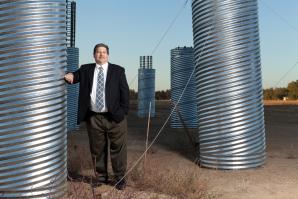“Why don’t we start at the top and work our way down?” The voice of Greg Kelly echoes as he stands in the empty lobby of his brand-new office building. He’s ready to begin the tour.
It’s about 10 a.m. on a Monday in October, the workweek well under way, and Kelly takes a high-speed elevator to the 12th floor of the 2020 Gateway Tower in Natomas.
“It’s a good day to be up here,” he says as he stares out the top-floor window. Cars zoom across Interstate 5 and the Sierra flirts with the distant fog, but hardly any cranes dot the downtown Sacramento skyline.
As the president and general partner of Bannon Investors Ltd., the developer of Gateway Tower, Kelly has seen this view before — the real estate market stalled by a strained economy — but never on this level.
The Class-A building came online in 2009 with 300,000 square feet of usable space, a state-of-the-art structure in a prime location. But according to commercial real estate advisers, the timing couldn’t have been worse. The recession put the Capital Region in a stranglehold like never before, stunting job growth and turning office buildings into hollow shells.
“I wasn’t around in the 1930s, but I’ve been through three recessions. What we’re experiencing these days is nothing like I’ve seen in my lifetime,” says John Frisch, regional manager of Cornish & Carey Commercial. “There are no jobs being created, office vacancy continues to increase and rents continue to decrease. It’s brutal being a building owner today.”
At the Gateway Tower, you won’t find workers clutching cups of coffee or flitting in and out of the elevators. No cars are parked in the ports under the solar panels. The building has no tenants. That means Kelly has to pay the bills out of his pocket.
Such a bleak outlook might cause other businessmen to blink. But not Kelly, whose roots in Sacramento run six generations deep. He comes from a line of men who always thought outside the bubble. He learned at a young age how to ride market cycles, so he designed the Gateway Tower with one word in mind: sustainability.
He hired architects and engineers to create a 12-story high-rise that would conserve water and energy and save on utility bills. They built a structure that saves almost 6 million gallons of water annually, and nearly 72 percent of the electricity for the shell and core comes from wind, solar and geothermal power. Hospital-quality filters remove 99 percent of the impurities in the air.
As a result, the 2020 Gateway Tower became the first private project in the Sacramento area to receive the LEED gold certification for a new building in January 2010. Just two blocks away, DPR Construction Inc. opened its own LEED-certified office in August 2003, but it only earned a silver rating. In Folsom, engineering firm Glumac recently completed its platinum-rated office. The difference, however, is Kelly and his firm didn’t build the office for themselves. It was built on speculation.
“We don’t build yesterday’s stuff,” Kelly says. “We try to see where we’re going before we start. The idea is to be future-proof, to be vital five to 10 years from now.”
To anyone who knows Kelly, his business conviction comes as no surprise. It’s in his blood. His grandfather, Ewing Kelly, founded KCRA radio in Sacramento in 1945. Kelly’s dad, Jon, and uncle, Bob, took over, and in 1961, they became the Kelly Broadcasting Co., which owned and operated KCRA Channel 3, an NBC affiliate, and several other affiliates until 1999.
In 1973, Jon founded River City Bank, the largest community bank in Sacramento, which has an asset base topping $1 billion. He led the development of the Natomas Corporate Center, a 70-acre office park developed in South Natomas, and leased about 700,000 square feet of office space in the late 1980s. As Bannon’s chief executive, Jon also guided the Gateway Tower project.
“They’re good business people, and they believe that giving back to the community makes it a better place,” says Jeanne Reaves, former president and chief executive of River City Bank. “Gregory was raised with that understanding and has grown up under that professionalism.”
On his mother’s side, Kelly’s trailblazing legacy goes back to the gold rush days and a pioneer named Patrick Bannon.
The story goes that Bannon, a sheriff and assistant warden at the prison in Joliet, Ill., took an arduous journey west on a wagon to escape the harsh winters that aggravated his pneumonia. He arrived in Sacramento, made money and returned to Illinois to get his family.
“This tough son of a gun made that trip three times,” Kelly says.
Bannon eventually bought acreage where the American and Sacramento rivers converge. According to history books, he built a big house with a 4-foot foundation of bricks, which protected the house against regular flooding. He would eventually sell his land, but the Kelly family, without even knowing the back story, acquired a large chunk of that land in the 1960s and 70s, Kelly says, bringing the journey full circle.
And at that point, Kelly’s own path was just starting to take shape. He attended the Lawrenceville School in Lawrenceville, N.J., and the University of Denver. The family business was booming, but Kelly didn’t want a free pass based on bloodline. So, after he graduated, he started building his resume with various sales roles for broadcasting companies in California and the NBC Television Network in New York.
At age 30, he decided to go about his father’s business. He joined Kelly Broadcasting as an intern under the tutelage of Jon and Bob Kelly. Special treatment was out of the question.
“Jon would chew us both out if we weren’t thinking out of the box,” says Val Nicholas, vice president and creative director of NBC Universal/MSNBC, who worked with Kelly at KCRA. “We always thought bigger than everyone else in town, and that’s why I think we did so well.”
After moving up to management, Kelly drove the creative engine for the station and was tasked with thinking up the most outlandish ways to package news items. They turned the lighting of the station tower into a Christmas event. They showed the credit roll for the movie “Jurassic Park” in advance to eliminate the gap between the movie and the news segment. They studied TV stations around the globe on a mission to become the No. 1 affiliate worldwide.
“Greg was always the one who was pushing us to go bigger, be more innovative,” Nicholas says. “He will not follow the leader and do what everyone else is doing.”
This is his strategy: Examine other people’s takes on specific topics, then toss out those ideas and start from scratch. Kelly begins with the big idea and fills in the details later. That’s how he was raised.
Growing up, he also learned the value of giving back. Active in the community in his role as president of the Kelly Foundation, he contributes to local charities and the arts, including the Stanford Home for Children, Special Olympics, Sacramento Philharmonic Orchestra and the Crocker Art Museum.
“I think those gifts are characteristic of someone who cares about a greater civic good,” says Lial Jones, director of the Crocker Art Museum, adding that Kelly’s contributions have remained consistent. “During a year when philanthropy across the country is down 11 percent, that signifies someone who is committed.”
Marc Feldman, executive director of the Sacramento Philharmonic Orchestra, met Kelly recently for the first time. Even though Kelly had been an active donor for years, Feldman didn’t know what to expect of the man behind the money.
“When you’re sitting down with a major donor, you have a little bit of trepidation,” Feldman says. “But within the first few minutes with him, that all went away. You don’t expect someone who is going to be so down to earth.”
Kelly’s contributions signify a vested interest not only in the community, but also in the individuals that comprise it. In summer 2009, Dean Yurica, a stockbroker and father of four, was going through a rocky divorce and had been camping out in his office.
Kelly, who knew Yurica because their children went to the same school, invited them over for dinner one night. After they ate, Kelly led the family down to his basement, where he gave them a load of household items: beds, utensils, plates, pots and pans, glasses and more.
“The kids and I started a chain bringing stuff into the van,” says Yurica, who still sleeps on the bed Kelly gave him. “It turned out to be a whole household of furniture. What he did for me, I won’t ever forget.”
With his own 17-year-old son and 12-year-old daughter, Kelly knows what it means to be a parent. But he also has fears for the current generation. In his day, he was taught to work hard and give back, but he says those ideas have been eroded by egotism.
“I think there’s a sense of entitlement in younger people that didn’t exist 20 years ago,” he says. “I get the feeling that the idea is ‘What are you going to do for me? Not ‘What can I do for you?’ And I think that’s backwards.”
He raises his children with an emphasis on a hard work ethic and says he learns more about the world by looking at it through their eyes. He also learns by exploring. From taking pictures of jumping whales and rare hawks in the Galapagos Islands to fly-fishing in Florida, Kelly seeks the outdoors, traveling to places untarnished by industry and sharing those experiences with others.
Kenneth Brown, chief executive of Avisen Securities Inc., had no idea how to fly-fish until Kelly took him to the south fork of the Yuba River 15 years ago. Brown has been hooked ever since. They’ve ridden drift boats across the Madison River in Montana, where Kelly taught him that the key to fly-fishing echoes the fundamental real estate mantra: location, location, location.
“It wasn’t so much about tying flies or what type of fly you use,” Brown says. “It was more about the type of water we would look for.”
Kelly avoids the churning rapids and instead seeks out quiet pools, tucked behind boulders, where the water runs deeper. No surprise there. It’s in his nature to go against the current.
Back in the Gateway Tower, Kelly leads the way through the building’s corridors and ventilation rooms. The turbines remain off. Any excess electricity generated from the solar panels goes back into the grid. The building has little use for it now.
But with its green features and modern design, real estate advisers predict rewards, admiring the developers for taking the risk.
“It’s just a matter of time and money, and if you have the money, you can work with the time,” says Bob Dean, executive vice president and managing director at Grubb & Ellis Co., a commercial real estate advisory firm. “In Greg’s case, they certainly have the financial wherewithal to withstand these kinds of downturns. In the long haul, it will make returns and become a success.”
Kelly understands cash flow. He is also the president of KKN Inc., a private company specializing in the accounting and management of the Kelly Family holdings in banking, real estate and finance. He self-financed the building and even though he currently has to carry the load for the Gateway Tower, Kelly says this investment will ultimately pay off.
“What we don’t want to do is compromise long-term viability by being too hasty or too greedy,” he says. “Sure, we’re taking some shots to the head, but we can handle it. We’ve always been survivors.”
Recommended For You

Love Thy Neighbor
Sacramentans love infill development – until it actually happens
Infill development is promoted as an antidote to suburban sprawl and environmental degradation and is championed by city planners, environmentalists and policy makers of all persuasions. But as local developers Paul Petrovich and Phil Angelides have long known, infill leads to fights over allegations of increased traffic or environmental hazards.

If You Rebuild It
Serial entrepreneur Scott Syphax rises from the rubble
Scott Syphax is an unlikely person to garner a nickname like Dr. Doom. After all, the president and CEO of Sacramento-based Nehemiah Corp. of America is far too thoughtful and deliberate to be saddled with a sobriquet more in line with a snickering cartoon villain.



